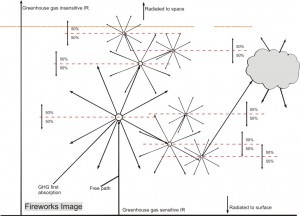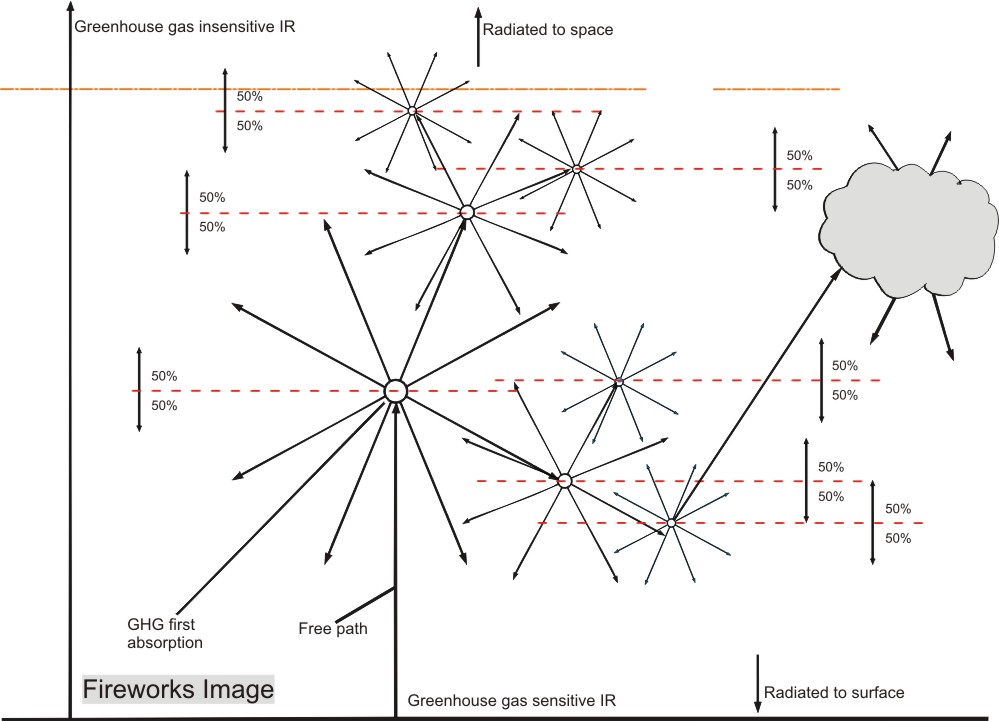The Fireworks approach on ClimateTheory.net
Notification (January 2021): this site is currently under (re-)construction, so content may change from day to day
What is ClimateTheory.net about?
The innovation that is the core of the www.climatetheory.net site is “The Fireworks atmospheric radiation simulation”.
It is an easy to understand Excel spreadsheet that can calculate exactly how much radiation is emitted into space and how much is absorbed by the earth surface, by using only a very simple formula.
It can do so, not only based on the radiation that is emitted from the surface, but also based on the IR energy that is absorbed from the solar irradiation, and released by condensation of water vapour, containing latent heat, higher in the atmosphere.
This is normally a very complex calculation, involving temperature, pressure and IR wavelength radiative properties. But in the Fireworks calculation, they can be left out.

The Fireworks basic idea (see chapter 1)
The great trick that enables this enormous simplification is to divide the atmosphere into layers, the height of which is defined as the average free path of greenhouse gas sensitive wave lengths, until they are absorbed by a greenhouse gas molecule. This definition incorporates all parameters that determine the free path, such as temperature, pressure and wave length. As soon as you have established the number of layers, and the layer into which the energy is absorbed or inserted by condensation, the calculation is extremely accurate.
The problem is of course moved to the determination of the number of layers, and the place where the energy is inserted. But that problem too can be solved rather easily, be it so far a lot less accurately. I am convinced that climate scientists will be able to do this in a very accurate way, at least accurate enough to use the simulation to achieve greater insight, and for a lot of other purposes.
Chapter 1 – 5: The Fireworks simulation and climate model
The first five chapters are explaining the simulation and the energy balance that is necessary to incorporate the other influences such as clouds and albedo in the Fireworks model, based on the simulation. They result in a Kiehl-Trenberth diagram containing the calculated energy flows in the atmosphere, and some conclusions about an atmosphere with twice the amount of CO2 in it.
Chapter 6 – 11: Convection, Hadley Cell and Missing Tropical Hot Spot
The next four chapters contain the first building blocks for quantifying the influence of greenhouse gases on convection. These chapters too contain a number of innovative new ideas that contradict generally accepted assumptions, both in sceptical and alarmist circles, about convection and the greenhouse effect.
The chapters 10 and 11 show how the Fireworks calculation can provide new insights on the radiative aspects of the Hadley cell and may even explain the so called “Missing Tropical Hot Spot”.
Fireworks concept presented at ICCC7 and ICCC10
First presentation at ICCC7 in Chicago, May 2012
On Monday evening, after a long day of lectures, I was given a chance to introduce the Fireworks concept to a few highly respected climate sientists, four of which were conference speakers.
Attendees: Prof. Dr Tom Segalstad (Univ. of Oslo), Prof. Dr Larry Gould (Univ. of Hartford), Prof Dr Fred Singer (NIPCC), Prof. Dr Sebastian Lüning ( co-author of Die Kalte Sonne, geologist), Dr Thomas P. Sheahen (Western Technology) and Prof. Dr Jeffrey Foss (Univ. of Victoria BC)
Not on the picture: John Kehr (author of The Inconvenient Sceptic)
Because it had been a very tiring day, I tried to be brief and to the point, concentrating on the Fireworks simulation. But the calculation of the emission of latent heat of the Hadley Cell to space, based on the simulation, certainly met with a lot of interest too.
Most of the attendants did not see the radiation theory as their core competence and were careful in formulating their reaction, but in general my feeling was that the theory was considered to be promising. (more…)

